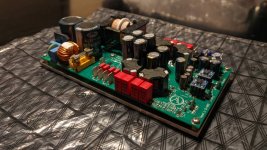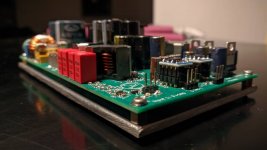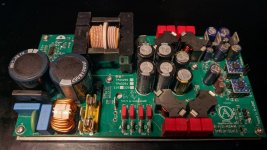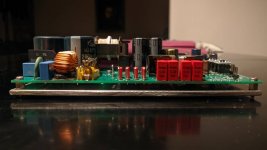there will be no next time. It gave me too many worries. In fact, I am already losing more than I gain. I soldered 15 boards, turned out to be defective, several vias have no contact. Now I quickly transfer everything to normal.
If you I can lower your stress by canceling my order I’m okay with money back. No problem with me, I’ve got more than enough projects laying around.
If you I can lower your stress by canceling my order I’m okay with money back. No problem with me, I’ve got more than enough projects laying around.
Easy ... except that Dr Mordor bought all the components for your card ...
He risks not finding so much ...
and we are waiting
Sorry for the highjack... It appears some mentioned my 2 position attenuator in this thread.
To clarify, nothing fancy or magic, and it would work whenever you have a traditional pot (or equivalent) inside an amp (or upstream in a sperate box or inside a preamp). So it works in 99% of the cases except if you have a very fancy unusual amp that requires a special impedance pot to work with other stages. To make it short, of course it could fit instead of a Blue Alps (in this project and others) and as reported it sounds better and cost 5$.
Even better, we did the calculation already for most of you, so you only have to copy paste (and worst case you change 4 resistors for 2$). Indeed, the impedance value I chose is 20k, which fits all modern needs (you could alter that, simply recalculating resistors values). The attenuation steps I chose (which is -28dB) appear to work provided you have a source with roughly 2V output and an amp gain structure between say 20 and 32dB (very usual values). In that case you can try the exact posted values without calculation and t is very likely to work from low efficiency speakers up until high efficiency speakers with at least 96dB/W/m in domestic listening rooms of small to large size.
It is likely to be still Ok with speakers that have a bit more than 96dB/W/m efficiency, that is from the values we gathered, but we didn't try first hand as we don't have such speakers. If you have very rare and unusual "well over 100dB/W/m efficiency speakers", then you may want to consider simply shifting the values I chose for both "steps" (say going for -10dB and -38dB instead of 0dB and -28dB, easy), but that is very unlikely and I won't develop that. It would also be very easy though to define your own steps, as we did BTW... but as some struglle with a voltage divider we kept it simple for the forum.
Again, all this applies if you are using digital sources only and have an OK pure digital volume control on your digital player.
Have fun
Claude (out again, sorry for the interference in this interesting thread of Dr. Mordor)
EDIT: for more info, visit the Aiyima thread and if questions please post there.
To clarify, nothing fancy or magic, and it would work whenever you have a traditional pot (or equivalent) inside an amp (or upstream in a sperate box or inside a preamp). So it works in 99% of the cases except if you have a very fancy unusual amp that requires a special impedance pot to work with other stages. To make it short, of course it could fit instead of a Blue Alps (in this project and others) and as reported it sounds better and cost 5$.
Even better, we did the calculation already for most of you, so you only have to copy paste (and worst case you change 4 resistors for 2$). Indeed, the impedance value I chose is 20k, which fits all modern needs (you could alter that, simply recalculating resistors values). The attenuation steps I chose (which is -28dB) appear to work provided you have a source with roughly 2V output and an amp gain structure between say 20 and 32dB (very usual values). In that case you can try the exact posted values without calculation and t is very likely to work from low efficiency speakers up until high efficiency speakers with at least 96dB/W/m in domestic listening rooms of small to large size.
It is likely to be still Ok with speakers that have a bit more than 96dB/W/m efficiency, that is from the values we gathered, but we didn't try first hand as we don't have such speakers. If you have very rare and unusual "well over 100dB/W/m efficiency speakers", then you may want to consider simply shifting the values I chose for both "steps" (say going for -10dB and -38dB instead of 0dB and -28dB, easy), but that is very unlikely and I won't develop that. It would also be very easy though to define your own steps, as we did BTW... but as some struglle with a voltage divider we kept it simple for the forum.
Again, all this applies if you are using digital sources only and have an OK pure digital volume control on your digital player.
Have fun
Claude (out again, sorry for the interference in this interesting thread of Dr. Mordor)
EDIT: for more info, visit the Aiyima thread and if questions please post there.
Last edited:
Thanks, I gladly follow youSorry for the highjack... It appears some mentioned my 2 position attenuator in this thread.
To clarify, nothing fancy or magic, and it would work whenever you have a traditional pot (or equivalent) inside an amp (or upstream in a sperate box or inside a preamp). So it works in 99% of the cases except if you have a very fancy unusual amp that requires a special impedance pot to work with other stages. To make it short, of course it could fit instead of a Blue Alps (in this project and others) and as reported it sounds better and cost 5$.
Even better, we did the calculation already for most of you, so you only have to copy paste (and worst case you change 4 resistors for 2$). Indeed, the impedance value I chose is 20k, which fits all modern needs (you could alter that, simply recalculating resistors values). The attenuation steps I chose (which is -28dB) appear to work provided you have a source with roughly 2V output and an amp gain structure between say 20 and 32dB (very usual values). In that case you can try the exact posted values without calculation and t is very likely to work from low efficiency speakers up until high efficiency speakers with at least 96dB/W/m in domestic listening rooms of small to large size.
It is likely to be still Ok with speakers that have a bit more than 96dB/W/m efficiency, that is from the values we gathered, but we didn't try first hand as we don't have such speakers. If you have very rare and unusual "well over 100dB/W/m efficiency speakers", then you may want to consider simply shifting the values I chose for both "steps" (say going for -10dB and -38dB instead of 0dB and -28dB, easy), but that is very unlikely and I won't develop that. It would also be very easy though to define your own steps, as we did BTW... but as some struglle with a voltage divider we kept it simple for the forum.
Again, all this applies if you are using digital sources only and have an OK pure digital volume control on your digital player.
Have fun
Claude (out again, sorry for the interference in this interesting thread of Dr. Mordor)
EDIT: for more info, visit the Aiyima thread and if questions please post there.
Thanks, I gladly follow you
Topic with the potentiometer is very interesting ...
Nice that such people exist and share their knowledge with others.
I think it's really great ... Super ......
 🙂
🙂Good evening Vitaly,
everything is fine with you...🙂
Do you have an appointment when the Akita will be shipped?🙂
Best wishes
everything is fine with you...🙂
Do you have an appointment when the Akita will be shipped?🙂
Best wishes
might be a while, read post 878. Sounds like a problem with the boards when they were made.
No, if you read the forum carefully, the amplifiers from Cardone, Mamocel and someone else have been shipped and returned to the sender so there must be a new shipment.
might be a while, read post 878. Sounds like a problem with the boards when they were made.
As Nerone wrote, the amplifiers were sent to Mamocel and me.
After 10 days, the packages sent were returned to Vitaly because something was wrong with the label.
Now we are waiting for Vitaly to send you back to us with the correct address ...
But that has nothing to do with post 878 ....
Just to report that I was crazy lucky that my wife traveled to Moscow, so she took the opportunity to take an amplifier and bring it home. I would like to thank Vitaly once again for his kindness and dedication, despite the situation with the pandemic and the problems he encounters when sending the package.
I wish everyone good luck with the Akita project! 🙂🙂🙂




I wish everyone good luck with the Akita project! 🙂🙂🙂




Last edited:
Great, let me know how it sounds as I seem to be the sole owner of Akita to this day
Nerone now you're not the only one who has Akita .....😀😀😉
Hi Vitaly,
I am still waiting for my 4 boards in Canada. Do you have an estimate of when you will be shipping them?
Thank you,
Rod
I am still waiting for my 4 boards in Canada. Do you have an estimate of when you will be shipping them?
Thank you,
Rod
Even me too as per your last post mine was supposed to be shipped out last Monday. Please check and let me know if this has been shipped.
thanks
thanks
Thanks for the kind words.J I would like to thank Vitaly once again for his kindness and dedication, despite the situation with the pandemic and the problems he encounters when sending the package.
I wish everyone good luck with the Akita project! 🙂🙂🙂
Guys, within two weeks I'll try to send it to everyone.
- Home
- Group Buys
- Akita "AllInOne" Amp based on TPA325x PFFB+ and LLC PSU in one board.


